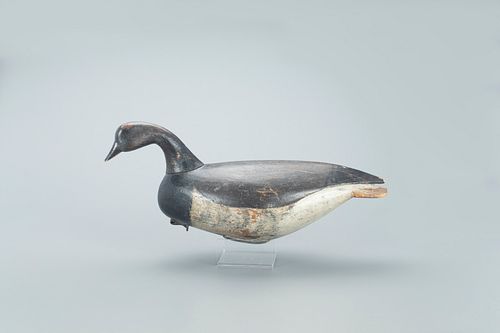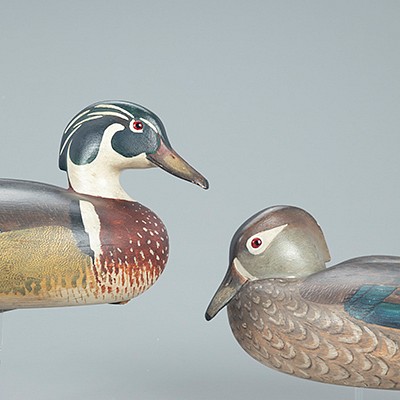Virginia Swimming Brant Decoy
About Seller
20 Winter Street
Pembroke, MA 02359
United States
Founded in 2005, Copley Fine Art Auctions is a boutique auction house specializing in antique decoys and American, sporting, and wildlife paintings. Over the course of the last two decades, the firm has set auction records for not only individual decoy makers, but also entire carving regions. Copley...Read more
Two ways to bid:
- Leave a max absentee bid and the platform will bid on your behalf up to your maximum bid during the live auction.
- Bid live during the auction and your bids will be submitted real-time to the auctioneer.
Bid Increments
| Price | Bid Increment |
|---|---|
| $0 | $50 |
| $1,000 | $100 |
| $2,500 | $250 |
| $5,000 | $500 |
| $10,000 | $1,000 |
| $25,000 | $2,500 |
| $50,000 | $5,000 |
About Auction
Mar 4, 2022
Lots 1-264 Copley Fine Art Auctions cinnie@copleyart.com
- Lot Description
Virginia Swimming Brant
Northampton County, VA, c. 1870
20 1/2 in. long
"This Roothead decoy is one of the most stylish solid body Cobbs to ever come to the market. Its finely carved primary wings come to a sharp point overlapping a wonderfully squared tail section, unique to the Cobb style. This distinction alone makes this decoy extremely rare." — Richard W. Oliver, "American Bird Decoys from the Collection of Milton C. Weiler," November 7, 1991
In 1991 this decoy was featured on the cover of Richard W. Oliver's "American Bird Decoys from the Collection of Milton C. Weiler." This swimming brant was part of the Milton C. Weiler Collection for over thirty years.
Milton Christian Weiler (1910-1974) hailed from Buffalo, New York, and graduated from Syracuse University's School of Fine Arts. An avid sportsman, Weiler was known for his paintings and illustrations which featured a myriad of field and stream subjects. In the 1930s, he was introduced to Eugene Connett, who founded Derrydale Press. Impressed with Weiler's inspired depictions of nature scenes, Connett hired him to illustrate four Derrydale Press books.
Weiler became a fixture in the early decoy collecting scene, and collaborated with his friend William J. Mackey for the "Classic Shorebird Decoys: A Portfolio of Paintings," which was published in 1971. Mackey and Weiler were also known to have road tripped together in the pursuit of decoys.
At the Weiler sale, this decoy was acquired by one of the nation’s premier collections, where it has resided for the last thirty years.
Many believe that Northampton County, Virginia, produced the finest brant decoys known. This may in part be due to a special affinity for the species that the barrier islanders showed. Case in point, Nathan Cobb Sr. kept a tame flock of brant on his island home, which were a local attraction and even once collateral for hotel construction loans.
This early brant demonstrates all of the bold features that define the Cobb Island style, while varying from the island’s standard. The curve along the back, long and deep wing cut, flared tail, pronounced lower profile, and delicate head carving produce a suite of lines that make this bird distinct from its Northampton County peers, including the known Cobbs, Doughtys, and Bradys. The sweeping lines are reminiscent of Robert Andrews from Smith Island, who is known for his curlew.
The original root head is in a swimming position, turned slightly to the left and finished with delicate eye grooves. Reflecting this subtlety, the underside of the tented tail is slightly concave. The underside of the tail bears a "J.P." brand.
The rarity of this great sculpture cannot be overstated; no closely related examples have surfaced. Given the storm-ravaged history of the area, this comes as little surprise. The form, condition, and provenance of this swimmer place it among the great unknown decoys.
Old working paint with heavy gunning wear, including some age lines. Tip and underside of bill has been replaced.
Provenance: Milton C. Weiler Collection
Private Collection
Literature: Richard W. Oliver’s, "American Bird Decoys from the Collection of Milton C. Weiler," November 7, 1991, front cover and lot 295, exact brant illustrated. Henry A. Fleckenstein Jr., "Southern Decoys of Virginia and the Carolinas," Exton, PA, 1983, back dust-jacket cover, p. 166, pl. 322, The Andrews running curlew illustrated. Loy S. Harrell Jr., "Decoys: North America’s One Hundred Greatest," Iola, WI, 2000, p. 59, related Cobb brant illustrated. Dr. S. Lloyd Newberry, "Wings of Wonder: The Remarkable Story of the Cobb Family and the Priceless Decoys They Created on Their Island Paradise," Columbia, SC, 2020, front dust-jacket cover, related root heads illustrated, p. 232, The Mackey Muller Cobb feeding brant illustrated.Please email condition report requests to colin@copleyart.com. Any condition statement given is a courtesy to customers, Copley will not be held responsible for any errors or omissions. The absence of a condition statement does not imply that the lot is in perfect condition.Condition
- Shipping Info
-
Copley Fine Art Auctions does not handle the shipping of any items. Shipping is the sole responsibility of the buyer. Once your payment has cleared, and we have received your authorized shipping release form items may be released for shipment. Copley Fine Art Auctions, LLC shall have no liability for any loss or damage to such items. Buyers should allow up to four weeks for shipment.
-



 EUR
EUR CAD
CAD AUD
AUD GBP
GBP MXN
MXN HKD
HKD CNY
CNY MYR
MYR SEK
SEK SGD
SGD CHF
CHF THB
THB














